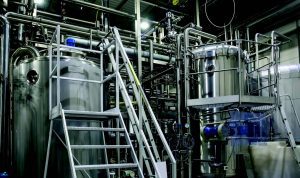
This article discusses the advantage of focusing on grades of stainless steel that contain relatively low levels of nickel to achieve both economic and environmental benefits. “We have a huge opportunity to enable the energy transition and save money. If we reduce primary nickel use in stainless steels, we can have a big influence on the price and availability of nickel for batteries, electrolysers etc., and also promote the cost-effective use of stainless steels,” explains the author.
By Roger Thomas
Background
Critical minerals are big news. The major global powers are scrambling to control territory where minerals are, or could be, mined and processed. Major studies have reported on the complexities of prospective demand and supply, and the grave implications for our peace, prosperity, and the viability of human civilization [1], [2], [3]. Nickel is regarded as a critical or strategic material with rapidly growing demand, most prominently driven by the growth in demand for lithium ion batteries (LIB) for electric vehicles (EV), although in 2024 65% of the 3.5 million tonnes of primary nickel production was still used to make stainless steels (STS). In 2023 and 2024, there was a surplus in primary nickel supply over demand, resulting in the LME price settling around $15k to $16k per tonne and the closure of some high-cost mines. Historically, shortages of nickel have seen the LME price to $30 to $50k/tonne [4].
Projected increasing demand is expected to lead to a shortfall of supply, despite the development of some large new mining and extraction projects. Studies from the IEA [1] and the Energy Transition Commission (ETC) [2] show a need for the investment of tens of billions of dollars in new primary production of nickel, and also in plants for recycling LIBs to produce secondary nickel and other metals.
Both studies also consider that evolving battery technology may be used to mitigate shortages and high prices of nickel (Ni). Manufacturers may select Ni-free LIB designs, which generally have lower energy density than LIBs with Ni-based cathodes. That infers reduced EV range which makes them less attractive, as does higher EV price due to high nickel price.
The ETC report also identifies nickel as a case in which future supply may be constrained by available reserves. However, both these studies may be underestimating the future demand for primary nickel for stainless steels and other alloys.
Underestimated future demand?
Sources focussed on the STS industry predict robust continuing growth, at compound annual growth rates (CAGR) ranging from 3% to 7%. The following are rough calculations for the stainless steel industry assuming a CAGR of 5%.
In 2024, 65% of the primary nickel production, ~2.4 million tonnes, was used in the production of 60 million tonnes of STS melt shop output. That is, primary nickel was ~ 4% of STS melt output.
Assuming a constant rate of primary nickel content and applying a CAGR of 5%, 4.1 million tonnes of primary nickel will be needed to make 100 million tonnes of STS in 2035. Followed by 5.2 million tonnes of primary nickel in 2040 and 8.5 million tonnes in 2050. The much lower IEA projections for nickel in alloys is based on expectation of greatly increased recycling of STS in China and other Asian countries as the STS flow ex-service increases, and also of lower growth in STS production.
Protocol principles
- The objective of this protocol is to minimize the use of primary nickel in the manufacture of stainless steels, to facilitate the use of nickel in batteries and other electrolytic processes
- Quantitative goal: reduce the global average primary nickel content of stainless steels from 4% in 2024 to 3% in 2035 and 2% in 2045
- Manufacturers will report the primary nickel content of each heat of stainless steel in the certification of material from that heat
- Companies manufacturing from stainless steel mill products will select a grade and supply chain of stainless steel appropriate for their application which will minimise primary nickel content of the stainless steel. They will stipulate a maximum primary nickel content as a condition of their purchase order for stainless steel
- Public companies manufacturing or processing stainless steels will report their primary nickel usage in their annual reports
- Companies selling stainless steel plant, equipment, infrastructure, or consumer goods will permanently mark these with the stainless steel grade to facilitate end-of-life recycling of the material.
Shifting to alloys with lower nickel
Reconsidering STS grade selection could be a way to reduce demand for primary nickel. The original stainless steel contained 18% chromium, for corrosion resistance, and 8% nickel to stabilise the austenitic structure which gave desirable mechanical properties.
That was the basis of the ‘300 Series’ austenitic STS which have 8 to 12% Ni. Today there are hundreds of STS grades. The 400 Series ferritic STS typically have <1% Ni, and volatility in the Ni price has driven companies such as IKEA [5] to make a sustained effort to change from 300 Series to 400 Series STS for applications in benign household environments.
Further, the World Stainless Association has pointed out that 400 Series STS with enhanced corrosion resistance are available which can replace 300 Series STS in most environments at ambient temperatures. Where the mechanical characteristics of austenitic STS are required, 200 Series STS containing 3 to 6% Ni are available. These contain enough Mn and N to stabilize the austenitic structure.
In China and other Asian countries where STS production is growing fastest, 400 Series and 200 Series are preferred but incorporation of recycled scrap is at a low rate because the material in service is not old enough to generate a lot of ex-service scrap. In Europe and North America, 300 Series STS continue to predominate, and the scrap incorporation rate is high, although it is a mix of STS and mild steels. The preference for 300 Series STS appears to be an example of market inertia due to consumer expectations; embedded specifications and part drawings; scrap availability and supply chain stocking practices.
| Scenario A | Scenario B | |
| Conditions | Business as usual in STS melting | Reduced nickel in STS |
| Nickel availability | Ni supply shortage => high price fo Ni | Ni supply covers demand => lower price for Ni |
| Percentage primary nickel in STS | 4% | 3% |
| Primary nickel for STS (million tonnes) | 4 | 3 |
| Primary nickel in LIB for EVs (million tonnes) | 2 | 2 |
| Market price of primary nickel ($/tonne) | $ 30,000 | $ 15,000 |
| Total cost of primary nickel in STS + EVs | $ 180 bn | $ 75 bn |
| Difference between scenario A and B | $ 105 bn / year |
Table 1: Scenarios A and B indicate the effects of applying best practice in selecting the STS grades and process routes using the least primary nickel.
Reducing nickel in STS
The author proposes coordinated global action to apply best practice in selecting the STS grades and process routes using the least primary nickel. The goal is to attain 3% primary nickel in global STS by 2035 [and 2% by 2045?]. That would reduce primary nickel consumption by 1 million tonnes / year, close the supply gap, and enable cost effective LIB production. Consider some crude arithmetic – see Table 1. Assume primary nickel for clean energy applications is ~ 2 million tonnes / year in 2035 and production of 100 million tonnes of STS.
Action plan

It may well be that ‘the unseen hand of the market’ will move us part way from Scenario A to Scenario B, but there will be volatility, time lags, missed opportunities, and undesirable side effects. How can we coordinate purposeful action in a market with dozens of producers and millions of consumers and supply chain intermediaries?
The author proposes the following:
- Highlight the issue of Ni use in STS to organizations coordinating action against Climate Change; STS stakeholders; and consumers worldwide
- Highlight the issue of Ni use in STS to organizations identifying critical minerals and securing supplies
- Define a protocol to be used in purchase orders for STS mill products and goods made from them, setting a maximum percentage for primary nickel content and requiring reporting of the actual primary nickel content in each heat of STS. See box ‘Protocol principles’
- Collaborate with The Chancery Lane Project [6] to incorporate the protocol into purchase orders for STS goods from retailers, engineering and construction companies.
This is a daunting action plan, but I take encouragement from the fact that we will be working with market forces, not against them. Also, from the famous words of Steve Jobs – “The people who are crazy enough to think they can change the world are the ones who do.”
If you are crazy enough to want to help,…………..

About the author
The son of a dairy farmer, Roger Thomas has an MA in Metallurgy and the Science of Materials from Oxford University, and an MBA from the University of Wales. After early jobs in battery R&D; failure analysis; and nickel alloy brazing and hard facing; Roger joined IMI Titanium in 1988.
The company was acquired by TIMET in 1996 and Roger served in a variety of technical roles including QA, market development, and R&D, retiring in 2018. He was the lead inventor on five TIMET patents for new titanium alloys with cumulative sales of those products exceeding $100M so far. Roger can be reached via: rttitanium@outlook.com / nidemand.wordpress.com
References
[1] “Global Critical Minerals Outlook 2024” International Energy Agency.
[2] “Materials and Resource Requirements for the Energy Transition” Version 1.0, July 2023, The Energy Transition Commission.
[3] “Critical Minerals and Great Power Competition, An Overview” Oct 2024, The Stockholm International Peace Research Institute.
[4] “Historical Nickel Prices” Index Mundi [https://www.indexmundi.com/commodities/]
[5] “The Ferritic Solution: Properties / Advantages / Applications” pub April 2007, International Stainless Steel Forum (now World Stainless Association).
[6] “The Chancery Lane Project” [https://chancerylaneproject.org/]
About this Tech Article
Appearing in the May 2025 issue of Stainless Steel World Magazine, this technical article is just one of many insightful articles we publish. Subscribe today to receive 10 issues a year, available monthly in print and digital formats. – SUBSCRIPTIONS TO OUR DIGITAL VERSION ARE NOW FREE.
Every week we share a new technical articles with our Stainless Steel community. Join us and let’s share your technical articles on Stainless Steel World online and in print.

